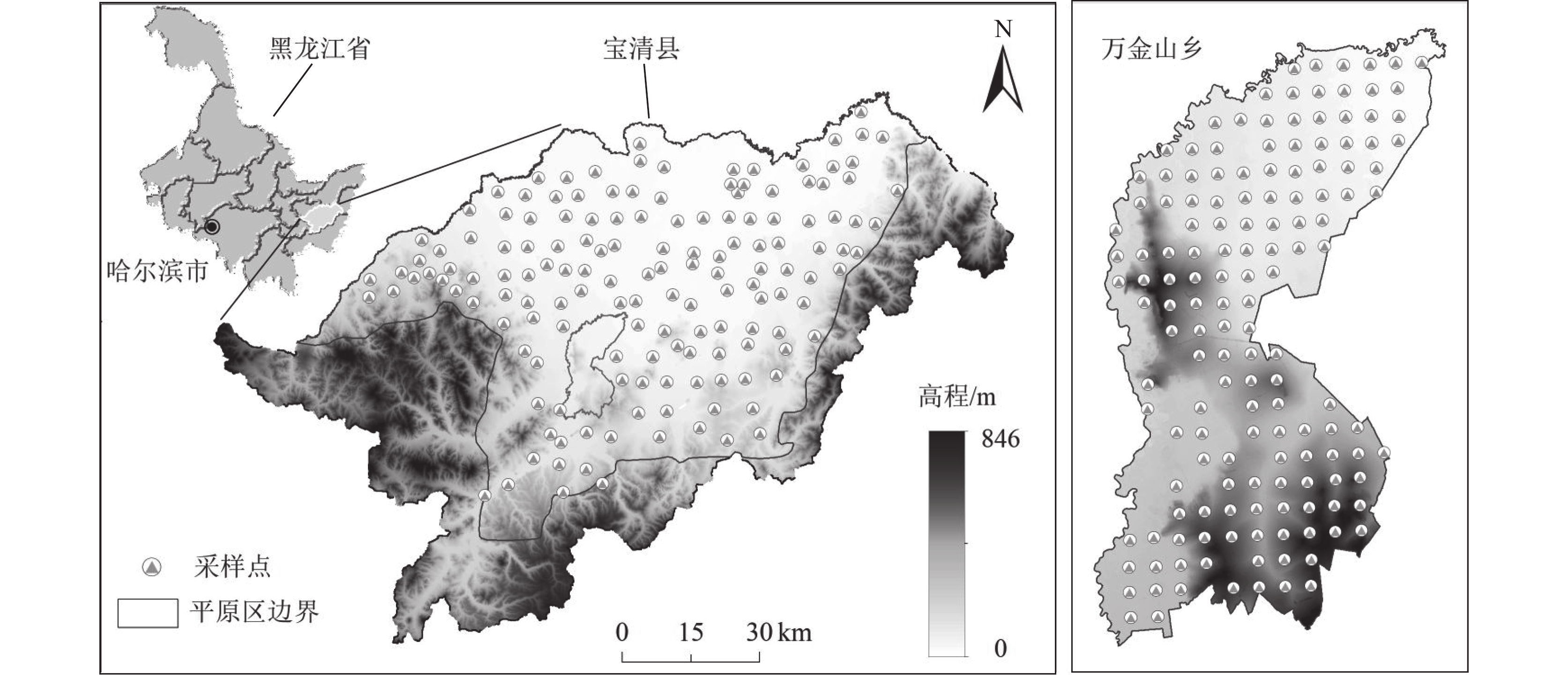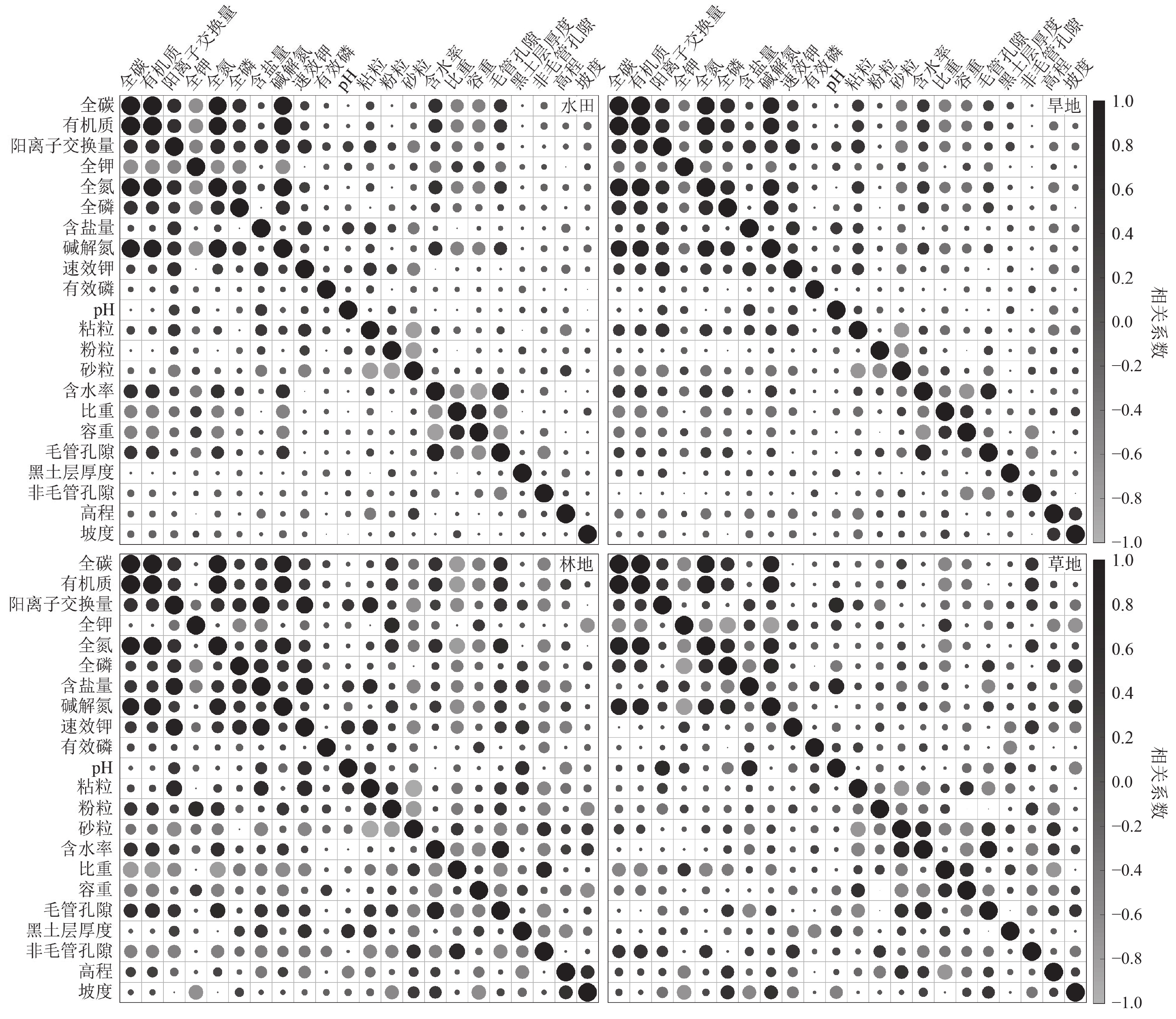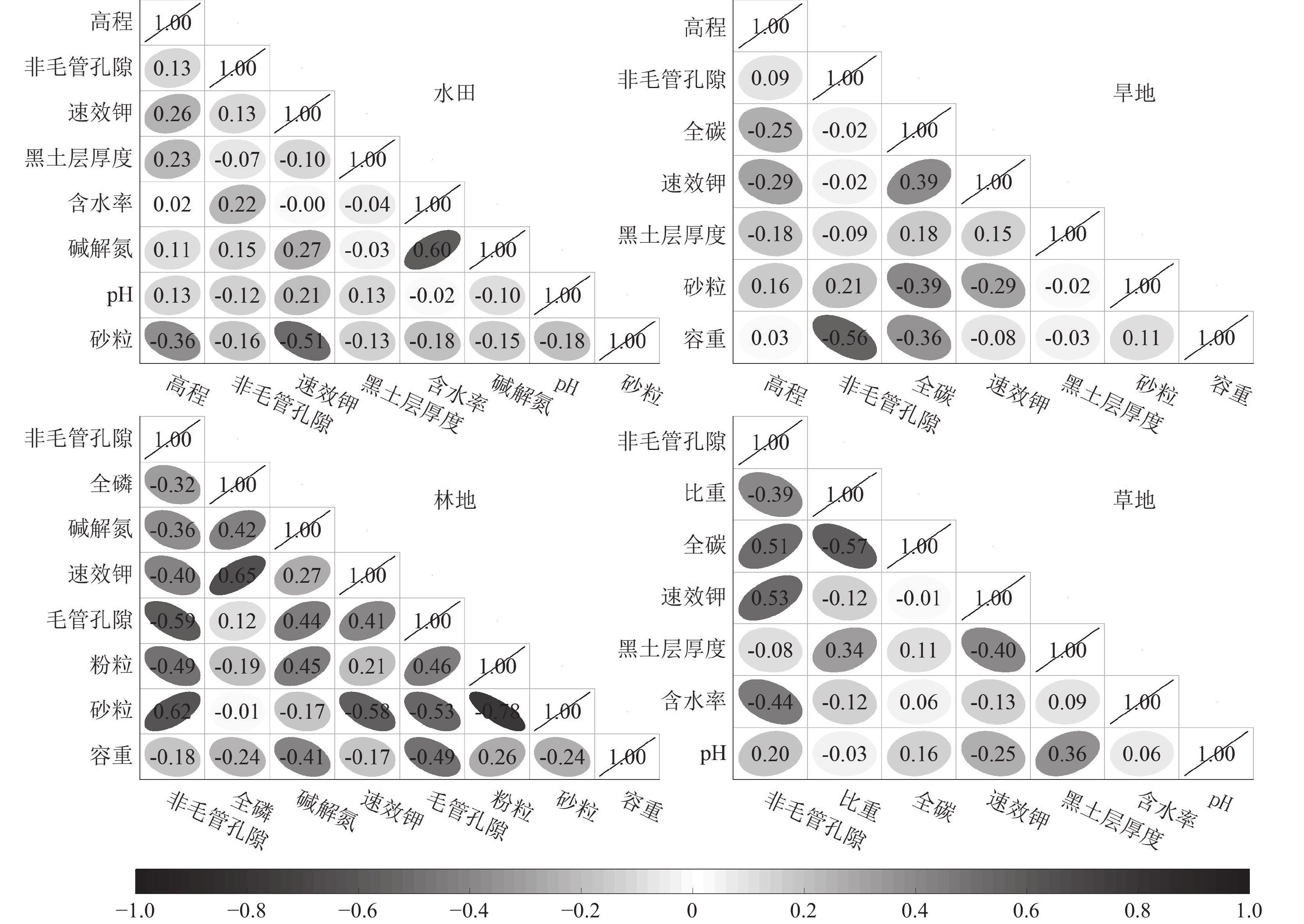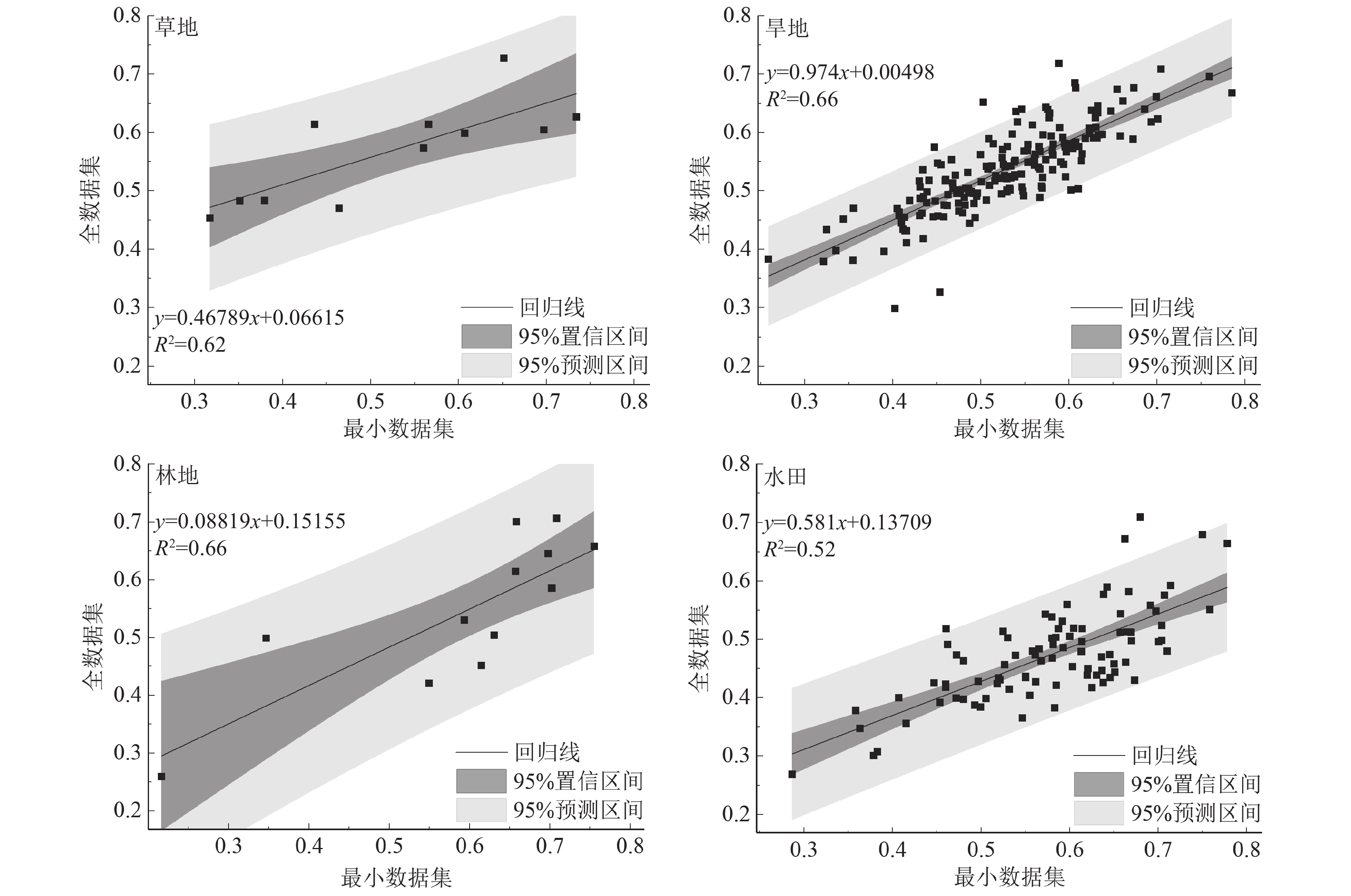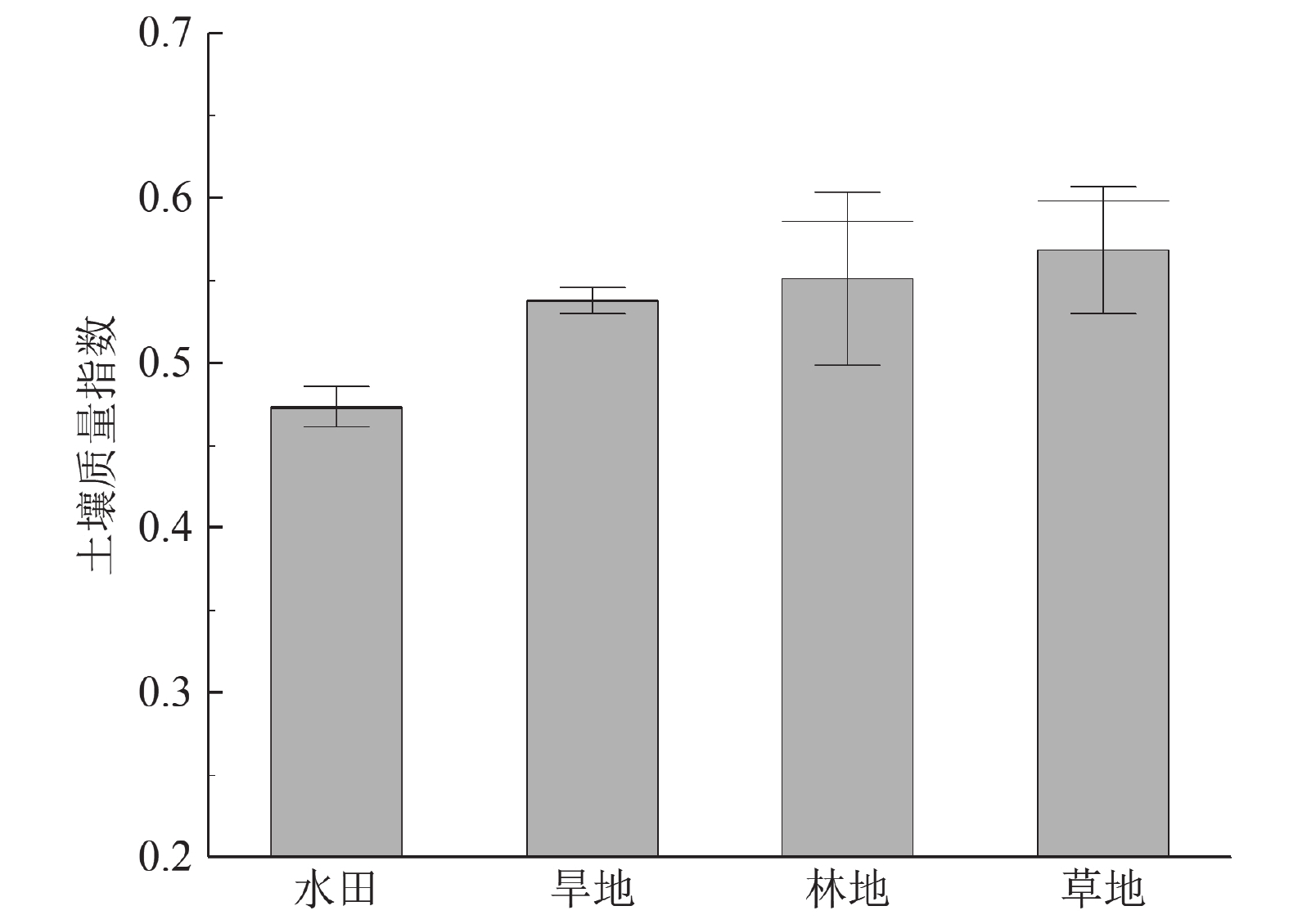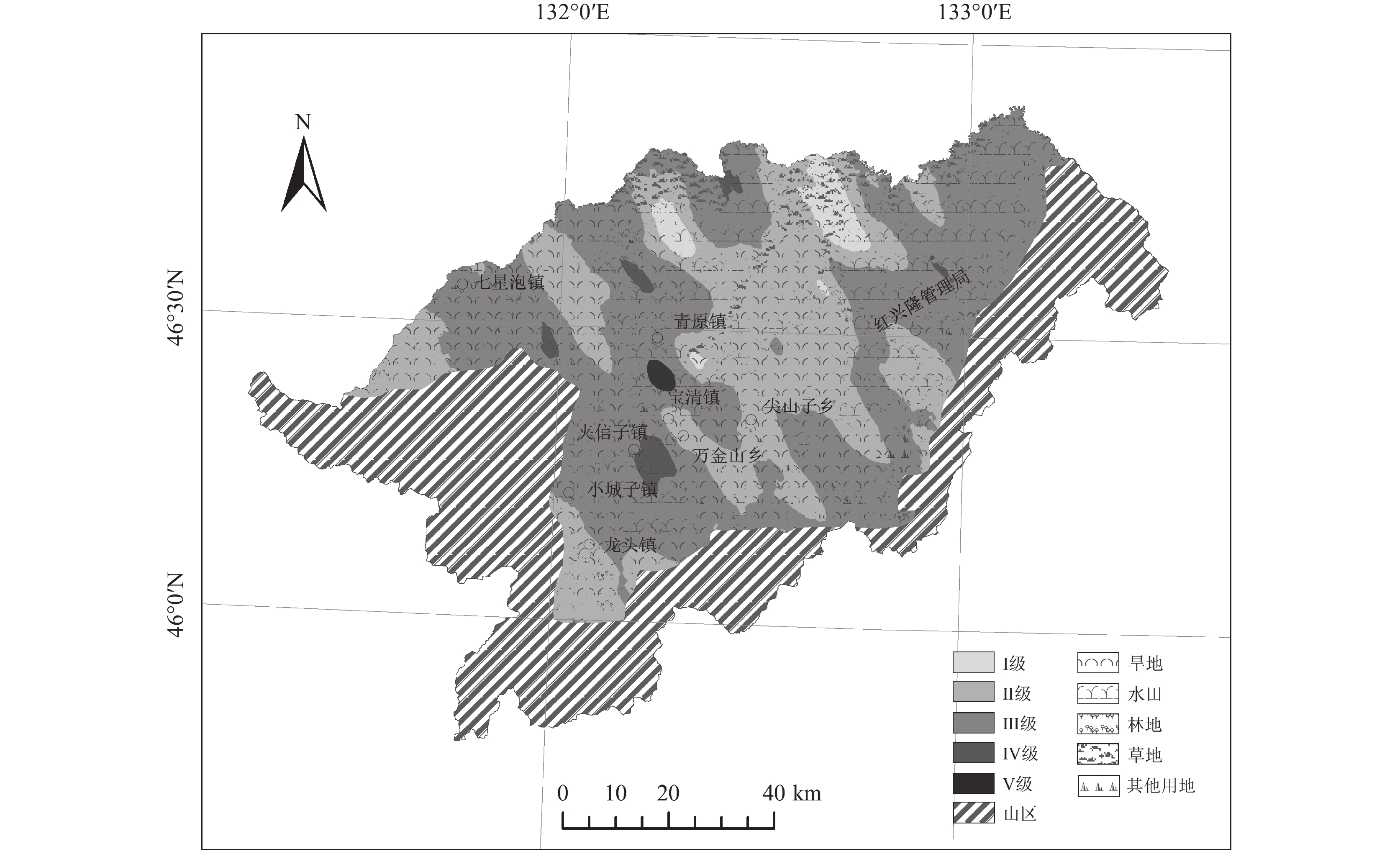Evaluation of black soil quality in Sanjiang Plain based on minimum data set: Taking the plain area of Baoqing County in Heilongjiang Province as an example
-
摘要:
土壤质量评价是实施精细化农业生产和土地科学管理的关键。对不同土地利用方式下的土壤质量进行评估并对其空间分布进行绘制,可以为优化土地利用空间布局,客观准确评价土壤质量和科学管理土地资源提供依据。以黑龙江宝清县平原区黑土地土壤为研究对象,综合选取31项评价指标作为全数据集(TDS),采用主成分分析(PCA)和相关性分析方法,确定不同土地利用类型的土壤质量评价的最小数据集(MDS)。利用地统计学方法,基于普通克里格插值法绘制土壤质量的空间分布图。结果表明,不同土地利用方式下的土壤质量存在明显差异,土壤质量整体表现为,草地>林地>旱地>水田。半变异函数为高斯函数的模型最适合预测土壤质量的空间分布。土壤质量在空间分布上呈现一定的规律性,越靠近北部挠力河流域,质量越好,大部分土壤质量处于中上水平,生产潜力较大。
Abstract:Soil quality evaluation is the key to the implementation of fine agricultural production and land scientific management. Evaluating the soil quality under different land use patterns and mapping its spatial distribution can provide a basis for optimizing the spatial layout of land use, objectively and accurately evaluating soil quality and scientifically managing land resources. In this study, the black soil in Baoqing Plain was taken as the research object, and 31 evaluation indexes were selected as the total data set (TDS). Principal component analysis (PCA) and correlation analysis were used to determine the minimum data set (MDS) of soil quality evaluation for different land use types. By using geostatistical methods, the spatial distribution map of soil quality was drawn based on the ordinary Kriging interpolation method. The results showed that there were significant differences in soil quality under different land use patterns. The overall performance of soil quality was grassland > forest land > dry land > paddy field. The model with Gaussian semi−variogram function was most suitable for predicting the spatial distribution of soil quality. The spatial distribution of soil quality showed a certain regularity. The closer to the northern Naoli River Basin, the better the soil quality. Most of the soil quality was in the middle and upper level, and the production potential was large.
-
Keywords:
- black land /
- land use type /
- minimum data set /
- geostatistics /
- semi-variogram
-
大别造山带不仅出露大面积的高压—超高压变质岩,而且发育大量的碰撞后岩浆岩(马昌前等,1999,2003;赵子福等,2009)。前人同位素年代学研究表明,大别造山带碰撞后岩浆活动高峰期为120~135 Ma(Xue et al., 1997;Hacker et al., 1998;薛怀民等,2002;赵子福等,2004;Xie et al., 2006;Wu et al., 2007;续海金等,2008)。这些燕山期的侵入岩以中酸性为主,同时还发育许多基性—超基性岩石。由于基性—超基性岩蕴含有大量的幔源信息,对这些岩石的研究,有助于了解大别造山带深部壳幔的地球化学特征及其相互作用。
从已有的资料看,前人对这些基性—超基性岩进行了一定的年代学和地球化学方面的研究(李曙光等,1997,1998,1999;陈道公等,1997,2001;聂永红等,1997;葛宁洁等,1999;王江海等,2002;王世明等,2010;Dai et al., 2011;谢清陆等,2016),但与同时期发育的中酸性岩相比,其研究程度明显不足。另外,前人的研究工作主要集中在北大别安徽段几个大的岩体,如椒子岩(陈道公等,1997;Zhao et al., 2005;李全忠等,2008)、沙村岩体(葛宁洁等,1999;赵子福等,2003;Zhao et al., 2005)等,对其他地方的基性—超基性岩报道较少。从近期工作看,在北大别湖北段也发育类似的基性—超基性岩,但野外特征上,相比于安徽段几个尚未发生变质变形的基性—超基性岩,湖北段基性—超基性岩发生了强烈的变质作用。这两类野外特征不同的基性—超基性岩,是否具相同的形成年龄和地球化学特征是需要查明的问题。对该问题的探讨,有助于对整个北大别地区基性—超基性岩的年代学研究和成因分析。
本文在1∶5万区域地质调查填图基础上,对北大别木子店地区的雷家湾辉长岩进行了岩石学、地球化学和年代学研究,并通过与安徽段基性—超基性岩研究成果进行对比,探讨了雷家湾辉长岩的岩石成因及其构造意义,为北大别地区晚中生代岩浆演化研究提供资料。
1. 地质背景及岩石学特征
大别造山带是三叠纪形成的碰撞造山带(徐树桐等,1992;徐树桐等,1994;杨巍然等,1999;汤加富等,2003;王勇生等,2004),先后经历了挤压作用、伸展作用、岩石圈减薄等多阶段作用过程(索书田等,2001;李曙光,2004;吴元保,2009;林伟等,2013;王清晨,2013;刘晓春等,2015)。大别造山带的东侧以郯庐断裂为界,西侧延伸可与秦岭造山带相连。碰撞后的伸展作用和晚燕山期以来的构造坍塌造就了大别造山带现今的构造样式。根据变质温度−压力条件,前人将该带划分为5个构造单元(Zheng et al., 2005),由北至南分别为北淮阳构造单元、北大别构造单元、超高压构造单元、高压构造单元和蓝闪−绿片岩构造单元。
大别造山带发育较多的燕山期基性—超基性岩,从分布位置看,它们主要位于北大别构造单元内。野外以小型侵入体、团块状或脉状与围岩呈侵入接触关系。本次研究的雷家湾岩体位于麻城市木子店镇北东方向13 km处,处于北大别构造单元罗田穹隆核部位置(图1)。岩体近卵圆形,直径约2 km,与围岩二长花岗岩呈侵入接触。从岩体中心向边部,岩性由辉长岩逐渐过渡到闪长岩。野外特征上,雷家湾岩体发生强烈的变质,局部形成斜长角闪岩。本次采集的雷家湾辉长岩,呈灰绿色,半自形—自形柱状结构,块状构造(图2−a,b)。主要矿物有斜长石、辉石、角闪石、黑云母、石英等,少量副矿物为磁铁矿、磷灰石、榍石等。斜长石呈板柱状,晶体表面普遍布满粘土矿物集合体(图2−c),但仍可见聚片双晶;辉石呈半自形—他形,多蚀变为角闪石;角闪石呈黄绿色柱状,伴有透闪石化;黑云母全部被绿泥石和铁质集合体取代,具残余片状假象(图2−d);石英呈他形粒状分布于长石粒间。副矿物磁铁矿多呈包体分布于主要矿物晶体内,磷灰石多呈包体较集中分布于暗色矿物晶体内,榍石呈楔形与磁铁矿伴生。
2. 样品分析方法
选取1个辉长岩样品(采样位置: 北纬31°14′28″、东经115°29′41″) 的锆石用于LA−ICP−MS U−Pb年龄分析,针对7个辉长岩样品进行了岩石全分析。
野外采集约25 kg的辉长岩样品,采用常规方法进行粉碎,经淘洗、电磁分选等步骤后分离出锆石﹐在双目镜下挑选锆石颗粒,将其粘在环氧树脂上进行制靶﹐用阴极发光(CL)照相确定锆石颗粒内部结构,便于后期进行锆石U−Pb同位素测定。锆石阴极发光CL照相在JSM6510扫描电镜上完成。
锆石的U−Pb年龄测定由中国地质调查局武汉地质调查中心实验室完成。锆石LA−ICP−MS定年采用的仪器型号为icapQ型,配备有 RESOlution 193 nm ArF 准分子激光剥蚀系统,束斑直径为29 μm,频率为6~8 Hz。采用标准锆石91500校正U−Pb同位素,NIST SRM612校正元素含量。单个数据点误差为1σ。采用ICPMSDataCal软件(ver.10.9)对同位素组成数据进行处理(Liu et al., 2008)。采用Isoplot程序计算锆石年龄加权平均值和谐和图的绘制(Ludwig, 2003)。
主量、微量元素测试在自然资源部中南矿产资源监督检测中心完成。主量元素采用波长色散X荧光光谱仪分析,型号为荷兰PW2440,误差优于3.2%;微量元素分析仪器为法国JY38S型光谱仪,误差优于4% 。
3. 分析结果
3.1 锆石U−Pb 年龄
对雷家湾辉长岩样品中17颗锆石进行了LA−ICP−MS定年测试,每颗锆石测试一个点,其同位素分析结果见表1。样品锆石呈无色、浅粉色,透明—半透明,晶形为半自形—他形。锆石晶体粗大,通常在150~200 μm之间,个别可达300 μm,虽然部分碎裂,但总体仍保留了较好的晶形,大部分晶体显示较好的振荡环带(图3)。锆石Th含量为72×10−6~1734×10−6,平均值804×10−6;U含量为97×10−6~596×10−6,平均值288×10−6;Th/U值较高,平均为2.61。这些特征表明,该锆石为辉长岩中典型的岩浆锆石。从本次测试的同位素数据看,17颗锆石点较集中,206Pb/238U年龄介于121.3±1.8~122.7±2.3 Ma之间(图4),其年龄加权平均值为122.3±1.0 Ma(MSWD=0.03,置信度为95%),代表辉长岩的结晶年龄。
表 1 雷家湾辉长岩LA−ICP−MS锆石U−Th−Pb同位素分析结果Table 1. Result of zircon LA−ICP−MS U−Th−Pb dating for the Leijiawan gabbro分析号 含量/10−6 232Th/
238U同位素比值 同位素年龄/Ma 谐和度 Total
Pb232Th 238U 207Pb/
206Pb1σ 207Pb/
235U1σ 206Pb/
238U1σ 207Pb/
206Pb1σ 207Pb/
235U1σ 206Pb/
238U1σ LJW-1-1 19.9 532 192 2.77 0.05060 0.0018 0.1335 0.0049 0.01916 0.00029 233.4 81.5 127.2 4.4 122.4 1.8 96% LJW-1-2 36.0 1082 451 2.40 0.04833 0.0011 0.1273 0.0031 0.01916 0.00026 122.3 53.7 121.7 2.8 122.4 1.7 99% LJW-1-3 8.9 236 139 1.70 0.04718 0.0019 0.1252 0.0057 0.01917 0.00034 57.5 92.6 119.7 5.2 122.4 2.1 97% LJW-1-4 22.5 654 211 3.10 0.04714 0.0016 0.1236 0.0039 0.01921 0.00036 57.5 74.1 118.4 3.5 122.7 2.3 96% LJW-1-5 50.0 1576 596 2.64 0.04815 0.0010 0.1271 0.0036 0.01911 0.00037 105.6 48.1 121.4 3.3 122.1 2.4 99% LJW-1-6 28.3 829 254 3.26 0.04949 0.0015 0.1303 0.0043 0.01912 0.00032 172.3 70.4 124.4 3.8 122.1 2.0 98% LJW-1-8 31.3 1014 274 3.70 0.04913 0.0015 0.1287 0.0042 0.01900 0.00029 153.8 76.8 122.9 3.8 121.3 1.8 98% LJW-1-10 6.4 72 129 0.56 0.04880 0.0023 0.1285 0.0061 0.01913 0.00034 200.1 104.6 122.7 5.5 122.1 2.2 99% LJW-1-11 30.1 937 359 2.61 0.04691 0.0012 0.1243 0.0036 0.01918 0.00030 42.7 63.0 119.0 3.3 122.5 1.9 97% LJW-1-12 53.3 1734 422 4.11 0.04685 0.0013 0.1235 0.0034 0.01918 0.00029 42.7 63.0 118.2 3.1 122.5 1.8 96% LJW-1-13 24.3 779 250 3.12 0.04875 0.0014 0.1291 0.0040 0.01921 0.00036 200.1 73.1 123.3 3.6 122.7 2.3 99% LJW-1-14 22.7 622 376 1.65 0.04901 0.0012 0.1299 0.0035 0.01922 0.00030 146.4 59.3 124.0 3.1 122.7 1.9 98% LJW-1-15 41.7 1316 362 3.63 0.04779 0.0013 0.1263 0.0038 0.01917 0.00031 100.1 58.3 120.8 3.4 122.4 2.0 98% LJW-1-16 4.7 85 97 0.88 0.04965 0.0024 0.1285 0.0060 0.01913 0.00044 189.0 119.4 122.7 5.4 122.2 2.8 99% LJW-1-18 24.9 778 230 3.38 0.05091 0.0015 0.1332 0.0039 0.01912 0.00032 235.3 66.7 127.0 3.5 122.1 2.0 96% LJW-1-19 14.2 385 225 1.71 0.04780 0.0016 0.1262 0.0046 0.01916 0.00035 100.1 77.8 120.7 4.2 122.4 2.2 98% LJW-1-20 31.5 1030 325 3.17 0.04847 0.0013 0.1275 0.0036 0.01912 0.00033 120.5 63.0 121.8 3.3 122.1 2.1 99% 3.2 主量元素
对雷家湾辉长岩7个样品进行了主量和微量元素分析,测试结果见表2。样品的烧失量为1.94%~4.12%,为了减少蚀变对岩石组分分析的影响,将烧失量扣除后,重新计算元素含量并归一至100%。岩石SiO2含量介于45.00%~50.69%之间,平均值为48.02%,属于基性岩范围。Al2O3含量介于11.88%~16.72%之间,平均值为15.42%。TFeO含量介于9.91%~15.64%之间,平均值为12.45%。MgO含量介于4.86%~8.44%之间,平均值为5.81%。TiO2含量介于1.61%~2.23%之间,平均值为1.79%。CaO含量介于6.64%~9.95%之间,平均值为8.16%。P2O5含量介于1.01%~1.50%之间,平均值为1.34%。K2O+ Na2O含量变化于4.68%~7.03%之间,平均值为6.31%,属于碱性系列。Mg#值变化范围在45.62~53.49之间,平均值为47.86,明显比原生岩浆的Mg#值低(60~71),暗示岩浆可能经历了结晶分异作用。在SiO2−(Na2O+K2O)图解(图5)中,所有样品点都落在碱性范围。
表 2 雷家湾辉长岩主量、微量和稀土元素分析结果Table 2. Major, trace and rare earth elements data for the Leijiawan gabbro样号 PM407/3-1 PM407/4-1 PM407/7-1 LJW-1 LJW-2 LJW-3 LJW-4 SiO2 48.13 43.20 49.12 46.71 46.58 45.37 47.38 TiO2 1.63 2.14 1.71 1.70 1.65 1.75 1.57 Al2O3 16.16 11.41 16.20 14.84 15.52 14.76 16.02 Fe2O3 4.68 6.20 3.34 5.11 5.06 5.77 4.88 FeO 6.87 9.44 6.60 7.63 7.53 7.98 7.06 TFeO 11.08 15.02 9.61 12.23 12.08 13.17 11.45 MnO 0.17 0.18 0.15 0.18 0.18 0.19 0.18 MgO 4.72 8.10 5.58 5.40 5.12 5.69 4.88 CaO 6.67 9.55 6.43 8.39 8.16 8.48 7.78 Na2O 3.55 1.64 3.56 2.89 3.05 2.79 3.18 K2O 3.28 2.85 3.23 3.21 3.24 3.14 3.30 P2O5 1.30 1.30 0.98 1.44 1.40 1.46 1.26 烧失量 3.21 4.12 3.88 1.94 2.20 2.20 2.14 总量 100.37 100.13 100.78 99.44 99.69 99.58 99.63 Mg# 45.75 51.64 53.49 46.65 45.62 46.10 45.76 La 115 69.6 93.6 108 109 88.1 122 Ce 222 152 182 218 212 180 236 Pr 26.3 18.6 21.6 26.5 25.2 22.0 26.2 Nd 103 77.0 83.6 107 101 89.7 104 Sm 17.1 14.0 13.5 18.3 16.9 15.7 17.0 Eu 4.26 3.44 3.28 4.46 4.28 3.93 4.26 Gd 13.6 11.2 11.0 14.6 13.6 12.4 14.3 Tb 1.70 1.39 1.37 1.83 1.67 1.53 1.69 Dy 7.70 6.58 6.24 8.38 7.56 6.91 7.62 Ho 1.31 1.12 1.08 1.43 1.34 1.14 1.31 Er 3.27 2.73 2.67 3.55 3.20 2.79 3.30 Tm 0.410 0.350 0.340 0.460 0.410 0.370 0.400 Yb 2.46 2.15 2.05 2.78 2.49 2.25 2.48 Lu 0.310 0.280 0.260 0.350 0.320 0.300 0.330 Y 31.1 27.9 25.6 34.9 31.4 27.6 33.2 ΣREE 518 360 423 516 499 427 541 LREE 488 335 398 482 468 399 509 HREE 30.8 25.8 25.0 33.4 30.6 27.7 31.4 LREE/HREE 15.9 13.0 15.9 14.4 15.3 14.4 16.2 LaN/YbN 33.5 23.2 32.8 27.9 31.4 28.1 35.3 δEu 0.854 0.840 0.823 0.834 0.863 0.861 0.835 Rb 63.5 79.8 78.4 74.7 76.6 82.2 70.0 Ba 4000 4320 3890 4460 4560 4950 4370 U 0.700 0.820 0.440 1.41 0.990 1.21 0.840 Th 8.03 5.54 6.08 8.29 7.54 8.62 9.34 Ta 0.570 0.480 0.730 0.650 0.630 0.780 0.580 Nb 14.7 10.3 20.8 13.7 13.1 13.4 13.0 Pb 11.2 9.8 11.8 12.1 12.9 12.5 12.4 Sr 1880 895 1420 1780 1960 1720 2050 Zr 154 99 212 154 214 217 196 Hf 4.14 3.23 4.80 3.98 4.89 4.99 4.50 注:TFeO=FeO+Fe2O3*0.8998;Mg#=100*MgO/[MgO+0.505*(FeO+0.9*Fe2O3)];δEu=Eu/Eu∗=2EuN/(SmN+GdN) ;主量元素含量单位为%,微量和稀土元素含量单位为10−6 3.3 稀土和微量元素
样品稀土、微量元素测试结果见表2。在稀土元素球粒陨石标准化配分模式图中,7个样品均表现出相同的稀土元素配分模式(图6−a)。样品稀土元素总量(∑REE)变化范围为360×10−6~541×10−6,平均值为469×10−6;其中轻稀土元素(LREE)平均含量为440×10−6,重稀土元素(HREE)平均含量为29.2×10−6;LREE/HREE值为13.0~16.2,(La/Yb)N值为23.2~35.3,δEu为0.823~0.863。雷家湾辉长岩强烈富集LREE,亏损HREE,轻、重稀土元素分馏明显;稀土元素配分曲线为右倾模式,其特点与碱性玄武岩相似。无或弱负Eu异常,指示早期没有或者很少有斜长石析出。微量元素蛛网图(图6−b)显示,雷家湾辉长岩总体富集Rb、Ba、K、Sr等大离子亲石元素(LILE),亏损高场强元素(HFSE)Ta、Nb、Zr、Ti等,与岛弧型火山岩具有相似的微量元素特征。
![]() 图 6 北大别不同地段基性—超基性岩稀土元素球粒陨石标准化配分图(a)和微量元素原始地幔标准化蛛网图(b)a—不同地段基性−超基性岩稀土元素球粒陨石标准化配分图;b—不同地段基性−超基性岩微量元素原始地幔标准化蛛网图;99DBZ—椒子岩数据(据李全忠等,2008);01SHC—沙村数据(据赵子福等,2003)Figure 6. Chondrite-normalized REE petterns (a) and trace element spider diagram (b) for mafic-ultramafic rocks in different regions of North Dabie
图 6 北大别不同地段基性—超基性岩稀土元素球粒陨石标准化配分图(a)和微量元素原始地幔标准化蛛网图(b)a—不同地段基性−超基性岩稀土元素球粒陨石标准化配分图;b—不同地段基性−超基性岩微量元素原始地幔标准化蛛网图;99DBZ—椒子岩数据(据李全忠等,2008);01SHC—沙村数据(据赵子福等,2003)Figure 6. Chondrite-normalized REE petterns (a) and trace element spider diagram (b) for mafic-ultramafic rocks in different regions of North Dabie4. 讨 论
4.1 北大别不同地段基性岩对比
早期,由于测试手段和测试精度的不同,关于北大别中生代基性—超基性岩的形成时代有不同认识,主要分为印支期和燕山期(同碰撞和碰撞后)2种观点(李曙光等,1989,1997,1998,1999;Hacker et al., 1995,1998;陈道公等,1997,2001;聂永红等,1997,1998;Jahn et al.,1999;葛宁洁等,1999;Tsai et al., 2000)。随着近年来高精度锆石U−Pb同位素定年方法越来越普及,学者们对北大别基性—超基性岩的形成时代已初步达成共识,即主体侵位时间为130~120 Ma(Hacker et al., 1998;葛宁洁等,1999;李曙光等,1999;王江海等,2002;Wang et al., 2005;Zhao et al., 2005;王世明等,2010;Dai et al., 2011;Dai et al., 2012;谢清陆等,2016)。本次在北大别湖北段木子店地区采集的雷家湾辉长岩的结晶年龄为122.3±1.0 Ma,与北大别安徽段基性—超基性岩形成时代在误差范围内一致(表3;图7),进一步说明北大别不同地段的基性—超基性岩均形成于燕山期(碰撞后)。
表 3 大别造山带中生代基性—超基性岩年龄Table 3. Isotope age of the Mesozoic mafic-ultramafic rocks from Dabie Orogenic belt位置/岩体 岩性 年龄/Ma 定年方法 参考文献 小河口 闪长岩 127±6 TIMS锆石 李曙光等,1999 小河口 辉石岩 125.3±0.8 TIMS锆石 李曙光等,1999 祝家铺 闪长岩 130.2±1.4 TIMS锆石 李曙光等,1999 漆柱山 辉长岩 122.9±0.6 TIMS锆石 王江海等,2002 北大别 辉绿岩脉 128.3±0.1 全岩Ar−Ar Wang et al., 2005 北大别 煌斑岩 128.2±0.2 全岩Ar−Ar Wang et al., 2005 北大别 煌斑岩 129.6±0.2 全岩Ar−Ar Wang et al., 2005 北大别 辉绿岩脉 131.8±0.3 全岩Ar−Ar Wang et al., 2005 北大别 辉绿岩脉 127.6±0.2 全岩Ar−Ar Wang et al., 2005 沙村 辉长岩 128±2 TIMS锆石 Zhao et al., 2005 沙村 辉长岩 125±2 SHRIMP锆石 Zhao et al., 2005 沙村 辉长岩 125±3 SHRIMP锆石 Zhao et al., 2005 椒子岩 辉长岩 127±3 TIMS锆石 Zhao et al., 2005 金寨银沙畈 辉长岩脉 125.8±2.7 SHRIMP锆石 王世明等,2010 湖北大悟 闪斜煌斑岩脉 129.6±2.5 SHRIMP锆石 王世明等,2010 北淮阳 基性岩脉 129±1 SIMS锆石 Dai et al., 2011 道士冲 富斜长石角闪石岩 125±1 SIMS锆石 Dai et al., 2011 道士冲 富斜长石角闪石岩 129±1 LA−ICP−MS锆石 Dai et al., 2011 祝家铺 辉石岩 128±1 SIMS锆石 Dai et al., 2011 祝家铺 辉石岩 126±1 LA−ICP−MS锆石 Dai et al., 2011 祝家铺 富斜长石角闪石岩 126±2 SIMS锆石 Dai et al., 2011 祝家铺 富斜长石角闪石岩 126±1 LA−ICP−MS锆石 Dai et al., 2011 道士冲 角闪石岩 129±1 LA−ICP−MS锆石 Dai et al., 2012 祝家铺 角闪石岩 125±3 LA−ICP−MS锆石 Dai et al., 2012 道士冲 富斜长石角闪石岩 127±2 LA−ICP−MS锆石 Dai et al., 2012 祝家铺 角闪石岩 127±1 LA−ICP−MS锆石 Dai et al., 2012 ![]() 图 7 大别造山带中生代基性—超基性岩年龄频率图(资料来源见表3)Figure 7. Age spectrogram of the Mesozoic mafic-ultramafic rocks in the Dabie Orogenic belt
图 7 大别造山带中生代基性—超基性岩年龄频率图(资料来源见表3)Figure 7. Age spectrogram of the Mesozoic mafic-ultramafic rocks in the Dabie Orogenic belt从野外岩石特征看,雷家湾岩体从岩体中心向边部,岩性由辉长岩逐渐过渡到闪长岩,与安徽段基性—超基性岩具有相似的特征(葛宁洁等,1999;赵子福等,2003)。岩石化学方面,将2个地段的基性—超基性岩进行对比(图6)发现,二者具有相同的元素地球化学特征,均富集轻稀土元素和Rb、Ba、K、Sr等大离子亲石元素,明显亏损高场强元素(Ta、Nb、Zr、Ti等)和重稀土元素。
但值得注意的是,与前人研究的安徽段基性—超基性岩相比,雷家湾辉长岩具有更强的变质程度,其岩性为变质辉长岩,局部见斜长角闪岩,镜下具柱粒状变晶结构,且辉石多蚀变为角闪石。根据本次野外工作,结合前人研究成果,认为雷家湾辉长岩的变质作用可能与白垩纪岩浆后期热液的交代作用有关。至于同时代形成的、具有相同地球化学性质的基性—超基性岩,为何湖北段变质程度强于安徽段,可能与它们所处的构造部位有关:雷家湾岩体位于北大别构造单元罗田穹隆核部,因此受岩浆热和后期热液蚀变作用较强;而安徽段处于穹隆边部位置,岩石受到的热液交代作用较弱。
通过以上对比分析,北大别不同地段的基性—超基性岩具有相同的侵位时代,相似的岩相学和岩石化学特征,暗示它们具有相同的成因机制。
4.2 岩石成因
雷家湾辉长岩的SiO2含量低(45.00%~50.69%,平均值为48.02%),MgO含量较高(4.86%~8.44%,平均值为5.81%),表明其母岩浆来自于地幔。但是,部分地球化学特征反映其母岩浆具有地壳物质成分特点,如岩石明显富碱, K2O+ Na2O含量高,其值变化于4.68%~7.03%之间,平均值为6.31%;均富集轻稀土元素和Rb、Ba、K、Sr等大离子亲石元素,明显亏损高场强元素Ta、Nb、Zr、Ti等;在Zr−Zr/Y构造环境判别图(图8−a)上,样品显示板内玄武岩特征,而在Ta/Yb−Th/Yb构造环境判别图(图8−b)上,样品点位于活动大陆边缘弧范围,可能暗示其形成过程中有地壳物质加入。另外,前人的同位素研究表明,北大别基性—超基性岩具有高δ18O值(夏群科等,2002)、高87Sr/86Sr初始比值、低εNd(t)值等特征(Jahn et al., 1999;李曙光等,1999;陈道公等,2001;李全忠等,2008),说明幔源岩浆中有地壳物质的贡献。以上特征表明,雷家湾辉长岩的幔源母岩浆经历了地壳物质的加入。
地壳物质影响幔源岩浆主要通过以下2种方式:一种是源区的混合,即辉长岩母岩浆源区加入了地壳物质;另一种是母岩浆上升过程中遭受了地壳物质的混染。从雷家湾辉长岩的地球化学特征看,7个样品无论是微量元素蛛网图,还是稀土元素配分模式图都基本一致,说明其地球化学成分单一,岩浆上升过程中受到的地壳混染作用不明显;另外,从本次对雷家湾辉长岩锆石研究看,镜下显示没有熔蚀特征,也未见包体,且17颗锆石测试点年龄数据集中,没有发现古老残留锆石信息,说明未受到地壳物质的混染。因此认为,地壳物质对辉长岩幔源母岩浆的作用方式应该为源区的混合。
对于地壳物质加入到幔源母岩浆中的方式,本次研究认为可能与三叠纪以来扬子板块向华北板块俯冲后加厚岩石圈的拆沉作用有关。三叠纪,扬子板块向与华北板块俯冲,使大别造山带地壳加厚。但地球物理资料显示,目前大别造山带下部不存在山根,表明发生过岩石圈的拆沉作用;前人从岩石学、地球化学、地球物理等方面肯定了大别造山带岩石圈发生拆沉的可能性(高山等,1999;李超等,2002)。另一方面,大量研究表明,岩浆活动与岩石圈拆沉有密切关系(Sacks et al., 1990;Nelson, 1992;Kay et al., 1993),拆沉可使地壳抬升,并引发下地壳熔融,所以拆沉作用几乎与大规模的岩浆活动同时。综合以上特征,认为雷家湾辉长岩是由大别岩石圈地幔与拆沉的下地壳物质,在上涌的软流圈提供热源的条件下发生了部分熔融,形成具有富集特征的幔源母岩浆,于122 Ma左右上升侵位后形成。
4.3 构造意义
大别地区中生代以来,不仅有基性—超基性岩浆活动,更多的是发育大规模的中酸性岩。从大量年代学资料看,中酸性岩起始活动时间早,基性—超基岩晚,二者相差13 Ma左右,如目前大别地区报道的较老花岗岩的年龄为143±3 Ma和142±3 Ma(Wang et al.,2007),而基性—超基性岩的时代均不早于130 Ma(图7;表3)。马昌前等(2007)根据花岗岩的Sr/Y值,将花岗岩分为高Sr/Y和低Sr/Y值2种,并将时间限定在130 Ma,即高Sr/Y花岗岩的形成时代一般大于130 Ma,而低Sr/Y值花岗岩的形成时代一般小于130 Ma,因此将130 Ma视为造山带构造体制由挤压向伸展转换的时间,这与基性—超基性岩开始出现的时间吻合。基性—超基性岩的出现往往暗示岩石圈地幔物质熔融的开始,岩石圈地幔物质的熔融需要较高温度,而岩石圈拆沉导致的软流圈物质上涌能提供所需的热能。因此,笔者认为,大别地区中生代以来的岩浆活动是从下地壳的部分熔融开始的,于143 Ma左右形成时代较老的花岗质侵入体,直到130 Ma构造体制由挤压向伸展转换,引起加厚岩石圈发生垮塌,软流圈物质上涌;同时,由于早期下地壳部分熔融产生的熔体(早期的中酸性岩)被抽取后,富含石榴子石残留相物质的下地壳密度逐渐增大,也促进了加厚岩石圈物质拆沉进入软流圈。在上涌的软流圈物质提供热能的条件下,岩石圈地幔物质开始发生熔融,上升侵位后形成130 Ma以来的基性—超基性岩。
5. 结 论
(1)北大别木子店地区雷家湾辉长岩锆石U−Pb年龄为122.3±1.0 Ma,为早白垩世,与大别基性—超基性岩同期,是大别造山带碰撞后岩浆活动的重要组成部分。
(2)雷家湾辉长岩体与安徽段基性—超基性具有相似的野外特征,且地球化学特征均表现出富集大离子亲石元素Rb、Ba、K、Sr等和轻稀土元素,亏损高场强元素Ta、Nb、Zr、Ti等和重稀土元素,暗示二者具有相同的成因机制。
(3)雷家湾辉长岩的幔源母岩浆有地壳物质的加入,作用方式为源区的混合,地壳物质的加入可能与三叠纪以来扬子板块向华北板块俯冲后加厚岩石圈的拆沉作用有关。
(4)大别造山带中生代以来中酸性岩浆起始活动时间更早,基性—超基岩浆稍晚,130 Ma左右基性—超基性岩的出现可能暗示造山带构造体制由挤压向伸展转换。
致谢:LA−ICP−MS锆石U−Pb数据测试得到中国地质调查局武汉地质调查中心同位素地球化学研究室相关工作人员的帮助,野外期间得到中国地质大学(武汉)张欣、熊爱民协助,室内岩矿鉴定得到湖北省地质调查院邱玲教授级高工指导,稿件的修改得到两位审稿专家的指导,在此一并表示感谢。
-
表 1 适宜型隶属函数上、下界限取值
Table 1 The upper and lower bounds of the appropriate membership function
指标 粘粒含量/% 粉粒含量/% 砂粒含量/% 容重/(g·cm−3) pH 下限值 40 40 20 1.2 6.5 上限值 55 55 50 1.4 7.5 表 2 土壤质量评价指标描述性统计特征
Table 2 Descriptive statistical characteristics of soil quality evaluation indexes
指标 平均值 中位数 标准差 最小值 最大值 变异系数 偏度 峰度 粘粒/% 31.46 31.00 8.76 4.00 52.00 0.28 0.05 −0.26 粉粒/% 41.90 43.00 8.45 3.00 59.00 0.20 −1.07 1.99 砂粒/% 26.64 24.00 12.45 5.00 93.00 0.47 1.77 4.85 毛管孔隙/% 41.47 41.64 5.60 26.15 62.95 0.14 0.44 0.95 非毛管孔隙/% 8.73 7.83 4.42 2.11 26.03 0.51 1.01 1.04 黑土层厚度/cm 52.48 50.00 30.17 0.00 175.00 0.57 1.02 1.22 含水率/% 31.67 29.86 9.14 15.24 80.82 0.29 1.54 3.88 比重 2.54 2.54 0.08 2.32 2.73 0.03 0.02 −0.23 容重/(g·cm−3) 1.18 1.19 0.17 0.76 1.57 0.15 −0.13 −0.55 高程/m 83.09 73.54 24.27 53.99 250.08 0.29 1.78 6.60 坡度/° 1.08 0.40 1.55 0.05 10.82 1.43 3.20 13.47 全碳/(mg·kg−1) 2.93 2.69 1.31 0.85 11.30 0.45 2.83 13.28 有机质/(g·kg−1) 47.57 43.79 22.22 13.96 192.74 0.47 2.99 14.64 全氮/(g·kg−1) 2.23 1.97 0.99 0.62 7.80 0.45 2.41 8.95 全磷/(g·kg−1) 0.83 0.78 0.25 0.40 1.95 0.30 1.50 3.13 全钾/(g·kg−1) 19.20 19.20 1.44 14.20 24.00 0.07 −0.07 1.57 碱解氮/(mg·kg−1) 205.41 196.10 81.29 52.00 618.10 0.40 1.89 6.33 速效钾/(mg·kg−1) 231.33 218.00 87.67 73.00 566.00 0.38 0.66 0.15 有效磷/(mg·kg−1) 20.73 17.50 16.70 0.40 146.80 0.81 2.18 10.82 含盐量/(g·kg−1) 0.43 0.41 0.17 0.14 0.90 0.39 0.49 −0.24 阳离子交换量/
(cmol·kg−1)31.01 30.60 8.18 11.00 53.50 0.26 0.26 −0.43 pH 6.33 6.22 0.59 5.30 8.38 0.09 1.35 1.78 As/(mg·kg−1) 10.72 10.46 2.92 4.72 18.97 0.27 0.37 −0.44 Cr/(mg·kg−1) 67.68 67.30 10.71 35.80 115.40 0.16 0.63 2.81 Cu/(mg·kg−1) 24.59 24.70 4.74 11.10 47.00 0.19 0.53 1.85 Cd/(mg·kg−1) 0.08 0.08 0.03 0.03 0.18 0.34 1.08 1.38 Hg/(mg·kg−1) 0.04 0.04 0.01 0.02 0.13 0.29 3.12 21.03 Mn/(mg·kg−1) 859.49 851.00 418.01 153.00 1784.00 0.49 0.13 −0.96 Ni/(mg·kg−1) 30.21 29.90 6.00 15.10 58.10 0.20 0.91 3.06 Pb/(mg·kg−1) 25.33 24.80 3.30 13.60 38.30 0.13 0.44 0.98 Zn/(mg·kg−1) 63.96 64.20 12.33 23.70 100.80 0.19 −0.16 0.11 表 3 水田土壤指标主成分分析结果及因子
Table 3 Principal component analysis results and factors of paddy soil index
指标 PC1 PC2 PC3 PC4 PC5 PC6 Norm值 全碳 0.871 0.363 0.178 −0.042 −0.088 −0.056 2.110 有机质 0.858 0.357 0.178 −0.050 −0.107 −0.068 2.082 阳离子交换量 0.604 0.143 0.620 0.183 0.127 0.133 1.788 全钾 −0.806 −0.146 0.139 −0.262 −0.027 −0.024 1.901 全氮 0.868 0.340 0.211 −0.065 −0.107 −0.021 2.103 全磷 0.755 −0.017 −0.041 −0.160 −0.016 0.145 1.735 含盐量 0.081 −0.117 0.814 0.109 0.023 −0.010 1.438 碱解氮 0.875 0.361 0.144 −0.054 −0.103 0.000 2.112 速效钾 0.223 −0.110 0.755 0.175 −0.182 0.122 1.456 有效磷 0.140 −0.103 0.180 0.176 0.056 0.621 0.900 pH −0.236 0.177 0.627 −0.005 0.401 −0.057 1.348 粘粒 0.131 0.132 0.530 0.509 −0.336 0.040 1.305 粉粒 −0.030 0.051 0.200 0.833 0.045 −0.068 1.265 砂粒 −0.063 −0.114 −0.453 −0.835 0.181 0.017 1.479 含水率 0.324 0.890 −0.068 0.087 −0.166 −0.014 1.824 比重 −0.331 −0.719 −0.068 0.015 −0.073 −0.048 1.535 容重 −0.268 −0.872 0.021 −0.085 −0.279 0.072 1.766 毛管孔隙 0.198 0.834 −0.066 0.045 −0.421 −0.015 1.696 黑土层厚度 0.077 −0.082 −0.041 0.279 0.264 −0.735 1.021 非毛管孔隙 −0.078 −0.072 −0.026 −0.041 0.850 −0.011 1.092 高程 −0.033 0.014 −0.413 −0.147 0.302 0.554 1.051 坡度 −0.199 −0.032 −0.236 0.349 0.051 −0.041 0.795 特征值 5.130 3.425 2.960 2.102 1.577 1.314 贡献率/% 23.320 15.568 13.455 9.553 7.166 5.973 累计贡献率/% 23.320 38.888 52.342 61.895 69.061 75.034 表 6 草地土壤指标主成分分析结果及因子
Table 6 Principal component analysis results and factors of grassland soil index
指标 PC1 PC2 PC3 PC4 PC5 PC6 PC7 Norm值 全碳 0.964 0.096 0.133 −0.020 −0.113 −0.069 0.049 2.223 有机质 0.960 0.082 0.147 −0.108 −0.093 −0.025 0.041 2.217 全钾 −0.640 0.108 0.350 −0.499 0.410 −0.040 −0.035 1.898 全氮 0.947 0.000 −0.138 −0.160 −0.124 −0.087 0.024 2.194 全磷 0.618 0.117 −0.475 0.312 −0.290 0.147 0.088 1.820 含盐量 −0.197 −0.244 0.864 0.076 0.032 0.105 −0.307 1.813 碱解氮 0.890 0.167 −0.079 0.399 −0.032 −0.013 0.033 2.152 速效钾 0.056 −0.002 −0.235 −0.908 0.046 0.167 −0.122 1.553 有效磷 −0.069 0.079 0.225 0.016 0.124 0.928 0.087 1.355 pH 0.017 0.083 0.981 0.039 0.016 0.021 0.108 1.866 粘粒 −0.034 −0.806 0.073 0.102 0.131 0.359 0.392 1.739 粉粒 −0.143 −0.048 −0.087 −0.104 0.211 −0.062 −0.948 1.371 砂粒 0.137 0.816 −0.007 −0.023 −0.280 −0.303 0.310 1.759 含水率 −0.005 0.928 −0.053 0.180 0.008 0.191 0.236 1.864 比重 −0.451 −0.172 −0.026 0.187 0.846 0.011 −0.058 1.676 容重 −0.182 −0.692 −0.290 0.367 0.369 −0.146 0.153 1.726 毛管孔隙 0.080 0.821 −0.425 0.208 −0.006 0.124 −0.026 1.824 黑土层厚度 0.061 0.196 0.330 0.286 0.414 −0.751 0.031 1.469 非毛管孔隙 0.530 −0.225 0.280 −0.521 −0.141 −0.042 −0.519 1.772 高程 0.111 0.327 0.032 0.326 −0.807 0.015 0.243 1.500 坡度 0.247 0.109 −0.586 0.681 −0.003 0.090 −0.011 1.669 阳离子交换量 0.378 −0.139 0.722 −0.045 −0.134 0.042 0.284 1.689 特征值 5.164 3.732 3.561 2.569 2.161 1.812 1.786 贡献率/% 23.472 16.964 16.184 11.677 9.824 8.236 8.116 累计贡献率/% 23.472 40.436 56.621 68.298 78.122 86.358 94.474 表 4 旱地土壤指标主成分分析结果及因子
Table 4 Principal component analysis results and factors of dryland soil index
指标 PC1 PC2 PC3 PC4 PC5 PC6 PC7 Norm值 全碳 0.915 0.190 0.105 0.171 −0.062 0.032 0.120 2.104 有机质 0.917 0.197 0.085 0.154 −0.071 0.033 0.076 2.103 阳离子交换量 0.528 0.567 0.228 0.161 −0.137 0.130 0.188 1.587 全钾 −0.490 0.405 −0.268 −0.016 0.152 −0.211 0.013 1.379 全氮 0.921 0.125 0.065 0.123 −0.172 0.032 0.022 2.102 全磷 0.782 −0.025 −0.019 0.072 0.025 −0.174 −0.003 1.772 含盐量 0.076 0.804 0.029 −0.059 −0.133 −0.096 0.030 1.338 碱解氮 0.895 0.056 0.121 0.107 −0.044 0.004 −0.064 2.028 速效钾 0.297 0.778 0.021 0.053 −0.085 0.033 0.007 1.437 有效磷 0.064 −0.042 0.153 0.045 −0.080 0.757 0.032 0.924 pH −0.158 0.576 −0.039 0.036 −0.196 0.095 0.395 1.129 粘粒 0.316 0.461 0.355 0.097 −0.462 0.015 −0.191 1.339 粉粒 0.007 −0.083 0.832 0.005 0.268 0.069 0.025 1.291 砂粒 −0.246 −0.296 −0.842 −0.078 0.170 −0.059 0.129 1.474 含水率 0.107 −0.003 0.265 0.589 −0.107 −0.371 −0.139 1.073 比重 −0.278 −0.231 −0.077 −0.602 0.173 −0.013 −0.166 1.172 容重 −0.250 0.093 0.001 −0.883 0.005 −0.105 −0.058 1.400 毛管孔隙 0.306 −0.221 0.474 0.176 −0.115 −0.476 0.316 1.264 黑土层厚度 0.093 0.128 −0.030 0.012 −0.047 −0.026 0.841 0.969 非毛管孔隙 −0.070 −0.007 −0.400 0.607 0.137 0.503 −0.203 1.245 高程 −0.198 −0.165 0.060 0.060 0.806 −0.059 −0.155 1.230 坡度 0.008 −0.114 0.040 −0.157 0.806 0.019 0.004 1.134 特征值 5.041 2.639 2.180 2.053 1.841 1.329 1.195 贡献率/% 22.914 11.996 9.910 9.330 8.370 6.040 5.432 累计贡献率/% 22.914 34.910 44.820 54.150 62.520 68.560 73.992 表 5 林地土壤指标主成分分析结果及因子
Table 5 Principal component analysis results and factors of forest soil index
指标 PC1 PC2 PC3 PC4 PC5 Norm值 全碳 0.954 0.040 −0.004 0.224 0.089 2.380 有机质 0.947 0.000 −0.004 0.253 0.109 2.372 阳离子交换量 0.493 0.730 0.184 0.156 0.177 2.120 全钾 0.005 −0.204 −0.948 −0.059 −0.099 1.785 全氮 0.900 0.103 −0.120 0.335 −0.005 2.302 全磷 0.485 0.447 0.567 −0.266 −0.015 1.924 含盐量 0.405 0.799 0.301 0.113 0.126 2.166 碱解氮 0.964 −0.124 −0.011 −0.010 0.030 2.392 速效钾 0.391 0.891 0.122 0.010 −0.031 2.266 有效磷 0.086 −0.075 −0.017 −0.056 0.863 1.239 pH −0.157 0.746 0.009 0.092 −0.281 1.799 粘粒 0.043 0.757 −0.210 0.353 0.349 1.924 粉粒 0.447 0.141 −0.798 0.142 0.278 1.896 砂粒 −0.234 −0.597 0.511 −0.313 −0.372 1.887 含水率 0.445 −0.005 0.212 0.779 −0.032 1.692 比重 −0.751 −0.327 0.072 −0.257 −0.126 2.047 容重 −0.447 0.113 −0.463 −0.442 0.551 1.749 毛管孔隙 0.473 0.246 −0.069 0.789 0.043 1.802 黑土层厚度 −0.108 0.792 −0.086 −0.040 0.054 1.841 非毛管孔隙 −0.412 −0.360 0.094 −0.348 −0.610 1.663 高程 0.263 −0.689 0.219 0.320 0.009 1.820 坡度 0.020 −0.267 0.786 0.434 −0.095 1.698 特征值 6.065 5.230 3.269 2.496 1.949 贡献率/% 27.568 23.774 14.859 11.347 8.858 累计贡献率/% 27.568 51.342 66.200 77.548 86.405 表 7 最小数据集中土壤指标的公因子方差及权重
Table 7 Common factor variance and weight of soil index in minimum data set
土地利用类型 土壤指标 公因子方差 权重 水田 高程 0.579 0.196 非毛管孔隙 0.512 0.173 碱解氮 0.422 0.143 黑土层厚度 0.395 0.134 pH 0.469 0.159 砂粒 0.576 0.195 旱地 高程 0.511 0.162 全碳 0.692 0.220 速效钾 0.513 0.163 黑土层厚度 0.412 0.131 砂粒 0.413 0.131 容重 0.610 0.194 林地 碱解氮 0.611 0.172 速效钾 0.355 0.100 毛管孔隙 0.731 0.205 粉砂粒 0.922 0.259 容重 0.940 0.264 草地 全碳 0.904 0.327 速效钾 0.635 0.230 黑土层厚度 0.625 0.226 含水率 0.088 0.032 pH 0.508 0.184 表 8 土壤质量半变异函数参数
Table 8 Semi-variogram parameters of soil quality
函数类型 平均误差 均方根误差 标准化平均误差 平均标准误差 标准化均方根误差 指数 −4.589E-05 0.072 0.006 0.084 0.882 高斯 −6.024E-04 0.072 −0.003 0.082 0.899 球面 −4.558E-04 0.072 −0.005 0.083 0.895 三角 −5.543E-04 0.072 −0.006 0.083 0.897 -
Armenise E, Redmile−Gordon M A, Stellacci A M, et al. 2013. Developing a soil quality index to compare soil fitness for agricultural use under different managements in the Mediterranean environment[J]. Soil and Tillage Research, 130: 91−98. doi: 10.1016/j.still.2013.02.013
Abdel−Fattah M K, Mohamed E S, Wagdi E M, et al. 2021. Quantitative evaluation of soil quality using Principal Component Analysis: The case study of El−Fayoum depression Egypt[J]. Sustainability, 13(4): 1824. doi: 10.3390/su13041824
Bünemann E K, Bongiorno G, Bai Z, et al. 2018. Soil quality–A critical review[J]. Soil Biology and Biochemistry, 120: 105−125. doi: 10.1016/j.soilbio.2018.01.030
Chandel S, Hadda M S, Mahal A K. 2018. Soil quality assessment through minimum data set under different land uses of submontane Punjab[J]. Communications in Soil Science and Plant Analysis, 49(6): 658−674. doi: 10.1080/00103624.2018.1425424
Deng S H, Zeng L T, Guan Q, et al. 2016. Minimum dataset−based soil quality assessment of waterlogged paddy field in South China[J]. Acta Pedologica Sinica, 53(5): 1326−1333 (in Chinese with English abstract).
Gong L, Zhang X N, Ran Q Y. 2015. Quality assessment of oasis soil in the upper reaches of Tarim River based on minimum data set[J]. Acta Pedologica Sinica, 52(3): 682−689 (in Chinese with English abstract).
Hani A, Pazira E, Manshouri M, et al. 2010. Spatial distribution and mapping of risk elements pollution in agricultural soils of southern Tehran, Iran[J]. Plant, Soil and Environment, 56(6): 288−296.
Han X Z, Li N. 2018a. Research progress of black soil in Northeast China[J]. Scientia Geographica Sinica, 38(7): 1032−1041 (in Chinese with English abstract).
Han X Z, Zhou W X. 2018b. Effects and suggestions of black soil protection and soil fertility increase in Northeast China[J]. Bulletin of Chinese Academy of Sciences, 33(2): 206−212 (in Chinese with English abstract).
Jiang M, Xu L, Chen X, et al. 2020. Soil quality assessment based on a minimum data set: a case study of a county in the typical river delta wetlands[J]. Sustainability, 12(21): 9033. doi: 10.3390/su12219033
Li G L, Chen J, Tan M Z, et al. 2008. Establishment of a minimum dataset for soil quality assessment based on land use change[J]. Acta Pedologica Sinica, (1): 16−25 (in Chinese with English abstract).
Li X, Li H, Yang L, et al. 2018. Assessment of soil quality of croplands in the Corn Belt of Northeast China[J]. Sustainability, 10(1): 248. doi: 10.3390/su10010248
Lou Y B, Shi D M, Jiang G Y, et al. 2019. Evaluation of soil quality in the cultivated−layer of sloping farmland in purple hilly area based on minimum data set[J]. Science of Soil and Water Conservation, 17(5): 75−85 (in Chinese with English abstract).
Liao C, Wang D W, Tang L, et al. 2021. Construction of soil nutrient comprehensive evaluation system based on minimum data set in Chengdu Plain[J]. Earth and Environment, 49(2): 189−197 (in Chinese with English abstract).
Li B Y, Li H, Guo X N, et al. 2021. Evaluation of soil quality of cultivated land in Ningxia area based on minimum data set[J]. Jiangsu Agricultural Sciences, 49(9): 195−201 (in Chinese with English abstract).
Ministry of Ecology and Environment. 2018. Soil environmental quality risk control standard for soil contamination of agricultural land (Trial)(GB 15618-2018)[S]. Beijing: China Environment Press (in Chinese).
Mei N, Gu Y, Li D Z, et al. 2021. Soil quality evaluation in topsoil layer of black soil in Jilin Province based on minimum data set[J]. Transactions of the Chinese Society of Agricultural Engineering, 37(12): 91−98 (in Chinese with English abstract).
Miao S J, Zhao H F, Qiao Y F, et al. 2019. Assessment of tillage effects on soil quality for aeolian sandy soil in northeast China with tilth index[J]. Soil and Fertilizer Sciences in China, (4): 9−15 (in Chinese with English abstract).
Mulat Y, Kibret K, Bedadi B, et al. 2021. Soil quality evaluation under different land use types in Kersa sub−watershed, eastern Ethiopia[J]. Environmental Systems Research, 10: 1−11. doi: 10.1186/s40068-020-00196-z
National Soil Survey Office. 1998. Chinese Soil[M]. Beijing: China Agricultural Press (in Chinese).
Song Y H, Yang F C, Liu K, et al. 2022. A multivariate statistical analysis of the distribution and influencing factors of heavy metal elements in the cultivated land of the Sanjiang Plain[J]. Geophysical and Geochemical Exploration, 46(5): 1064−1075 (in Chinese with English abstract).
Tan M Z, Mi S X, Li K L, et al. 2011. Influence of elevation factor on soil profile texture configuration: a case study of the alluvial plain of Fengqiu County[J]. Acta Ecologica Sinica, 31(8): 2060−2067 (in Chinese with English abstract).
Tan Y, Chen H, Lian K, et al. 2020. Comprehensive evaluation of cultivated land quality at county scale: A case study of Shengzhou, Zhejiang Province, China[J]. International Journal of Environmental Research and Public Health, 17(4): 1169. doi: 10.3390/ijerph17041169
Wang X, Gong Z. 1998. Assessment and analysis of soil quality changes after eleven years of reclamation in subtropical China[J]. Geoderma, 81(3/4): 339−355. doi: 10.1016/S0016-7061(97)00109-2
Wang S H, Tian Y. 2003. Preliminary research on groundwater table change and causes in San−jiang Plain[J]. Journal of Irrigation and Drainage, (2): 61−64 (in Chinese with English abstract).
Wang Y Y, Yang Z F, Yu T. 2011. Research progress of soil quality evaluation[J]. Journal of Anhui Agricultural Sciences, 39(36): 22617−22622, 22657 (in Chinese with English abstract).
Wu H Y, Jin R D, Fan Z W, et al. 2018. Assessment of fertility quality of black soil based on principal component and cluster analysis[J]. Journal of Plant Nutrition and Fertilizers, 24(2): 325−334 (in Chinese with English abstract).
Wang W W, Zhu W Z, Li X, et al. 2021. Soil quality assessment of typical vegetation in dry and warm valley of Dadu River based on minimum data set[J]. Science of Soil and Water Conservation, 19(6): 54−59 (in Chinese with English abstract).
Xi X H, Chen G G, Zhang D C, et al. 2014. Specification of Multi-Purpose Regional Geochemical Survey (1:
250000 ) (DZ/T0258-2014)[S]. Beijing: Standards Press of China (in Chinese).Xu M X. 2003. Soil quality evolvement mechanism in the process of ecosystem restoration and its management in Loess hilly−gully region[D]. PhD Thesis of Northwest A&F University: 60−72. (in Chinese with English abstract).
Yang Z F, Yu T, Li M, et al. 2016. Specification of land quality geochemical assessment(DZ/T0295-2016)[S]. Beijing: Geological Press (in Chinese).
Yang L M, Li X Y, Ren Y X, et al. 2019. Soil quality evaluation of cultivated land in Changchun City based on minimum dataset[J]. Jiangsu Agricultural Sciences, 47(20): 305−310 (in Chinese with English abstract).
Yang Z Q, Qin F C, Yu X J, et al. 2019. Construction of artificial forest soil quality evaluation indices in the feldspathic sandstone region based on minimum data set[J]. Chinese Journal of Soil Science, 50(5): 1072−1078 (in Chinese with English abstract).
Yin M, Wang S M, Ye J Y, et al. 2006. The specification of testing quality management for geological laboratories(DZ/T 0130-2006)[S]. Beijing: Standards Press of China (in Chinese).
Zhang J, He C, Chen L, et al. 2018. Improving food security in China by taking advantage of marginal and degraded lands[J]. Journal of Cleaner Production, 171: 1020−1030. doi: 10.1016/j.jclepro.2017.10.110
Zhang F P, Gao Z, Li X J, et al. 2019. Soil quality assessment of kiwifruit field using MDS method in Zhouzhi County[J]. Journal of Ecology and Rural Environment, 35(1): 69−75 (in Chinese with English abstract).
Zhao Q G, Sun B, Zhang T L. 1997. Soil quality and sustainable environment I. Definition and evaluation method of soil quality[J]. Soils, (3): 113−120 (in Chinese).
Zhuo Z Q, Li Y, Gou Y X, et al. 2021. Quality evaluation and obstacle diagnosis of plough horizon based on minimum data set in dry farming region of Northeast China[J]. Transactions of the Chinese Society for Agricultural Machinery, 52(9): 321−330 (in Chinese with English abstract).
邓绍欢, 曾令涛, 关强, 等. 2016. 基于最小数据集的南方地区冷浸田土壤质量评价[J]. 土壤学报, 53(5): 1326−1333. 贡璐, 张雪妮, 冉启洋. 2015. 基于最小数据集的塔里木河上游绿洲土壤质量评价[J]. 土壤学报, 52(3): 682−689. 韩晓增, 李娜. 2018a. 中国东北黑土地研究进展与展望[J]. 地理科学, 38(7): 1032−1041. 韩晓增, 邹文秀. 2018b. 我国东北黑土地保护与肥力提升的成效与建议[J]. 中国科学院院刊, 33(2): 206−212. 李桂林, 陈杰, 檀满枝, 等. 2008. 基于土地利用变化建立土壤质量评价最小数据集[J]. 土壤学报, (1): 16−25. doi: 10.3321/j.issn:0564-3929.2008.01.003 娄义宝, 史东梅, 蒋光毅, 等. 2019. 基于最小数据集的紫色丘陵区坡耕地耕层土壤质量评价[J]. 中国水土保持科学, 17(5): 75−85. 廖程, 王德伟, 唐亮, 等. 2021. 基于最小数据集的成都平原某区土壤养分综合评价体系的构建[J]. 地球与环境, 49(2): 189−197. 李百云, 李慧, 郭鑫年, 等. 2021. 基于最小数据集的宁夏耕地土壤质量评价[J]. 江苏农业科学, 49(9): 195−201. 苗淑杰, 赵红飞, 乔云发, 等. 2019. 基于耕作指数评价耕作措施对东北风沙土耕层土壤质量的影响[J]. 中国土壤与肥料, (4): 9−15. 梅楠, 谷岩, 李德忠, 等. 2021. 基于最小数据集的吉林省黑土耕层土壤质量评价[J]. 农业工程学报, 37(12): 91−98. 全国土壤普查办公室. 1998. 中国土壤[M]. 北京: 中国农业出版社. 生态环境部. 2018.《土壤环境质量 农用地土壤污染风险管控标准(试行)》(GB 15618—2018)[S]. 北京: 中国环境出版社. 宋运红, 杨凤超, 刘凯, 等. 2022. 三江平原耕地土壤重金属元素分布特征及影响因素的多元统计分析[J]. 物探与化探, 46(5): 1064−1075. 檀满枝, 密术晓, 李开丽, 等. 2011. 冲积平原区高程因子对土壤剖面质地构型的影响——以封丘县为例[J]. 生态学报, 31(8): 2060−2067. 王韶华, 田园. 2003. 三江平原地下水埋深变化及成因的初步分析[J]. 灌溉排水学报, (2): 61−64. doi: 10.3969/j.issn.1672-3317.2003.02.016 汪媛媛, 杨忠芳, 余涛. 2011. 土壤质量评价研究进展[J]. 安徽农业科学, 39(36): 22617−22622, 22657. doi: 10.3969/j.issn.0517-6611.2011.36.154 吴海燕, 金荣德, 范作伟, 等. 2018. 基于主成分和聚类分析的黑土肥力质量评价[J]. 植物营养与肥料学报, 24(2): 325−334. doi: 10.11674/zwyf.17225 王文武, 朱万泽, 李霞, 等. 2021. 基于最小数据集的大渡河干暖河谷典型植被土壤质量评价[J]. 中国水土保持科学, 19(6): 54−59. 许明祥. 2003. 黄土丘陵区生态恢复过程中土壤质量演变及调控[D]. 西北农林科技大学博士学位论文: 60−72. 奚小环, 陈国光, 张德存, 等. 2014. 《多目标区域地球化学调查规范(1∶250 000)》(DZ/T0258—2014)[S]. 北京: 中国标准出版社. 尹明, 王苏明, 叶家喻, 等. 2006. 《地质矿产实验室测试质量管理规范》(DZ/T 0130—2006)[S]. 北京: 中国标准出版社. 杨忠芳, 余涛, 李敏, 等. 2016. 《土地质量地球化学评价规范》(DZ/T0295—2016)[S]. 北京: 地质出版社. 杨黎敏, 李晓燕, 任永星, 等. 2019. 基于最小数据集的长春市耕地土壤质量评价[J]. 江苏农业科学, 47(20): 305−310. 杨振奇, 秦富仓, 于晓杰, 等. 2019. 基于最小数据集的砒砂岩区人工林地土壤质量评价指标体系构建[J]. 土壤通报, 50(5): 1072−1078. 赵其国, 孙波, 张桃林. 1997. 土壤质量与持续环境Ⅰ. 土壤质量的定义及评价方法[J]. 土壤, (3): 113−120. doi: 10.3321/j.issn:0253-9829.1997.03.001 张福平, 高张, 李肖娟, 等. 2019. 基于最小数据集的周至县猕猴桃园地土壤质量评价[J]. 生态与农村环境学报, 35(1): 69−75. 卓志清, 李勇, 勾宇轩, 等. 2021. 基于最小数据集的东北旱作区耕层质量评价与障碍诊断[J]. 农业机械学报, 52(9): 321−330. doi: 10.6041/j.issn.1000-1298.2021.09.036




 下载:
下载:







